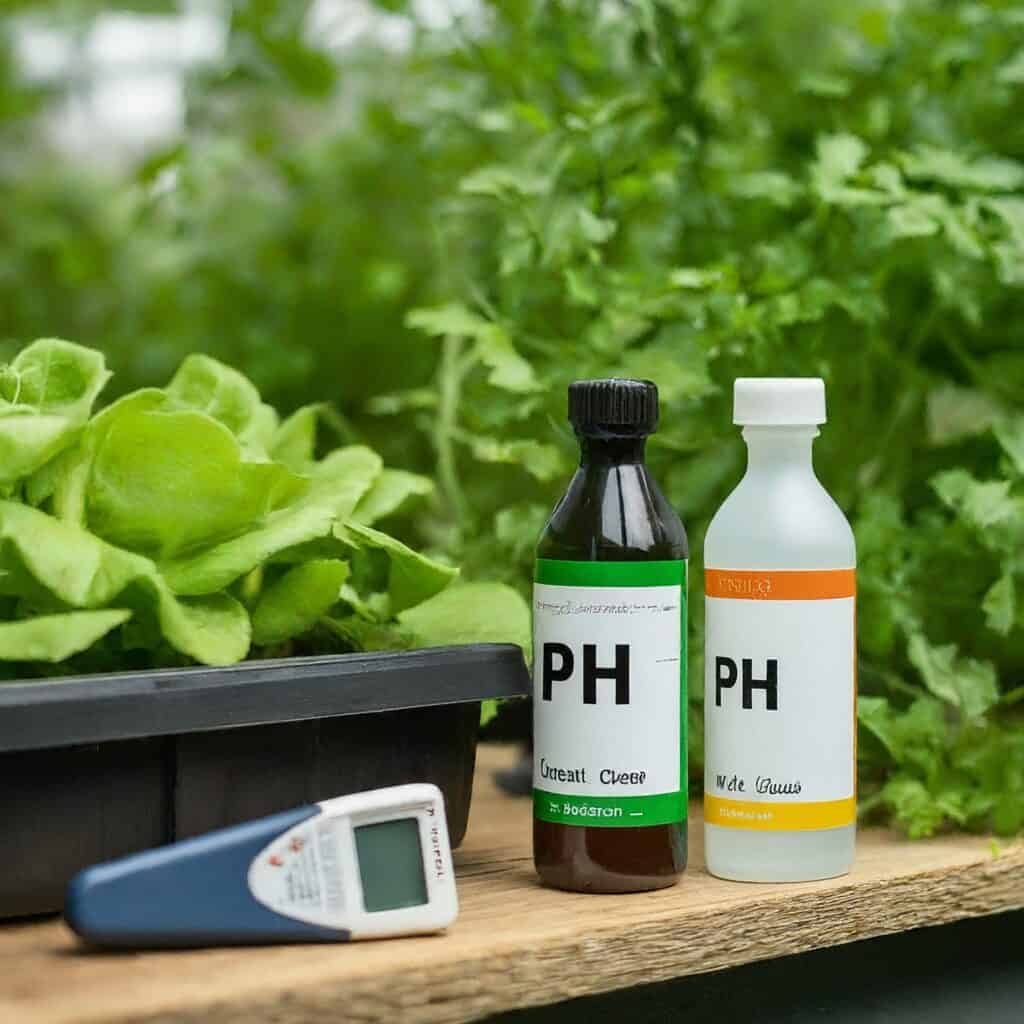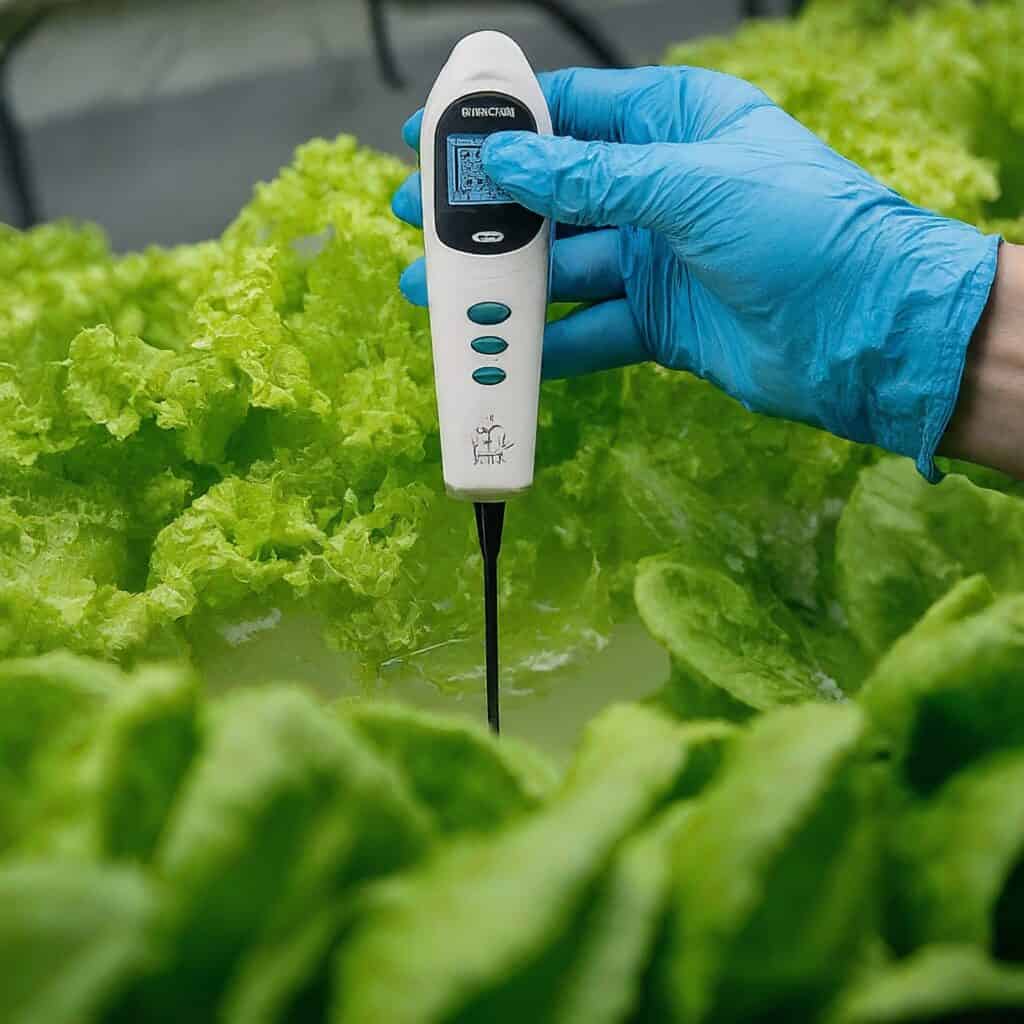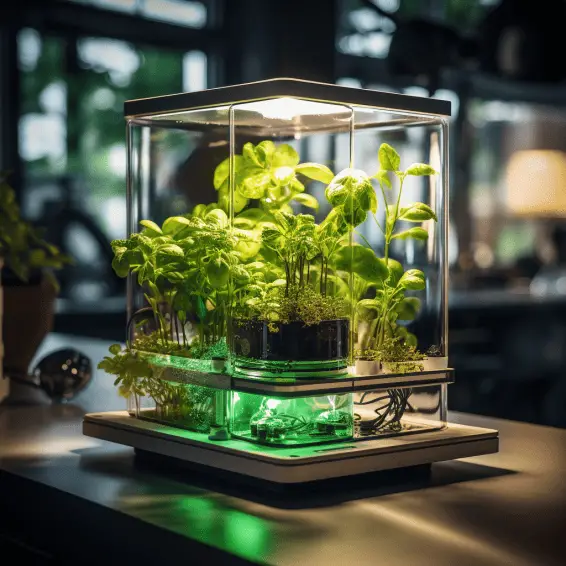Maintaining the perfect pH balance is crucial for a healthy hydroponic garden. Discover the simple pH adjusters that will help your plants thrive with ease.
KEY TAKEAWAY
- Maintaining the ideal pH range of 5.5-6.5 is crucial for healthy hydroponic plants, although some species like blueberries thrive in a more acidic environment.
- pH up and pH down solutions are specially formulated to raise or lower the pH of the nutrient solution, respectively, and should be used carefully according to the manufacturer’s instructions.
- Digital pH meters provide the most precise and reliable pH readings, but pH paper and liquid test kits can also be used to monitor the nutrient solution’s acidity or alkalinity.
Get the pH wrong and your hydroponic plants will not be happy campers. Just ask my pal – her peppers were not pleased! Websites like Hydrobuilder explain that pH adjusters for hydroponics, like pH Up and Down, can safely tweak levels up or down.
Whether starting new or tweaking old systems, these adjusters can help any grower keep their plants perky. Keep reading to discover my pH testing tricks along with a hilarious hack I learned the art way.
Choosing the Right pH Adjusters
I’ve learned that maintaining the proper pH level in your nutrient solution is crucial for the health and thriving of your plants. After years of trial and error, I’ve discovered the key to unlocking the secret to successful pH management.
Understanding Ideal pH Ranges
Different plants thrive in varying pH ranges. For most hydroponic crops, the sweet spot lies between 5.5-6.5. However, some plants like blueberries prefer a more acidic environment, with a pH range of 4.0-5.0. Understanding the unique needs of your plants is the first step to dialing in the perfect pH.
pH Up Solutions
When your nutrient solution becomes too acidic, you’ll need to raise the pH. Commonly used pH up solutions contain potassium hydroxide or calcium carbonate. Be sure to follow the manufacturer’s instructions closely when adding these, as a little goes a long way. Adjust slowly to avoid drastic swings in pH that can shock your plants.
pH Down Solutions
On the flip side, if your solution becomes too alkaline, you’ll need to lower the pH. Phosphoric acid and citric acid are popular pH down options. Again, use these products carefully and per the guidelines to prevent rapid pH drops that can harm your plants. (1)
Accurately Testing and Monitoring pH

Knowing the exact pH of your nutrient solution is crucial, so having the right testing tools is key.
Digital pH Meters
For the most reliable and precise readings, digital pH meters are the way to go. These handy devices provide accurate measurements, but require regular calibration to ensure they stay on point. (2)
pH Paper
pH paper is a simple and inexpensive option, but tends to be less accurate than digital meters. It’s great for quick spot checks, but may not be as reliable for dialing in the perfect pH.
Liquid pH Test Kits
These color-based comparison kits offer more precision than basic pH paper, making them a good middle-ground option. Just follow the instructions carefully to get an accurate reading.
Factors Influencing pH Fluctuations
Understanding what causes pH shifts is key to maintaining a stable, healthy environment for your plants.
Water Source
The pH of your water source can have a significant impact on your nutrient solution. Always test your water and make adjustments as needed before mixing your hydroponic nutrients.
Nutrient Solution
Even after initial pH balancing, the pH of your nutrient solution can fluctuate over time as plants uptake different nutrients. Regular monitoring and adjustment is a must.
Growing Medium
The type of growing medium you use can also affect pH. Some mediums have a higher buffering capacity, meaning they resist pH changes more than others. Know your medium’s characteristics to stay on top of pH swings.
Maintaining a Stable pH

Consistency is key when it comes to pH management in hydroponics. Here are some tips I’ve learned along the way:
Consistent Monitoring
Test your pH daily, or at least as frequently as recommended for your system. Staying on top of pH levels is crucial for plant health and optimal nutrient absorption.
Gradual Adjustments
When you do need to make pH adjustments, do so slowly. Allowing time for the solution to stabilize is important to avoid shocking your plants.
Calibration and Mixing
Remember to regularly calibrate your testing equipment to ensure accuracy. And always mix your nutrient solutions thoroughly to prevent pH imbalances.
By following these guidelines, you’ll be well on your way to mastering pH control in your hydroponic garden. It may take some trial and error, but the rewards of healthy, thriving plants make it all worth it.
FAQ
How do I choose the right ph adjusters for my hydroponic system?
Understanding the ideal pH range for your plants is key when selecting the right ph adjusters. For most hydroponic crops, the sweet spot is between 5.5-6.5 pH, while plants like blueberries prefer a more acidic 4.0-5.0 pH.
Carefully follow the manufacturer’s instructions when using ph up or ph down products to gradually adjust the ph of your nutrient solutions and avoid rapid changes that can stress your plants.
What is the best way to accurately test and monitor the pH in my hydroponic setup?
Digital ph meters provide the most reliable and precise pH readings, but require regular calibration to maintain accuracy. pH test kits offer a simple and affordable solution, though they may be less precise than digital meters.
Liquid ph test kits strike a nice balance, providing color-based comparisons that are more accurate than basic pH paper. Consistent monitoring is crucial to maintaining optimal pH levels for nutrient uptake and plant health.
How can I maintain a stable pH in my hydroponic system?
Regularly testing the pH of your water source, nutrient solutions, and growing medium is essential for identifying and addressing fluctuations.
Make gradual adjustments using ph up or ph down products, allowing time for the solution to stabilize and avoid shocking your plants. Proper mixing and thorough calibration of your testing equipment will also help keep your ph levels dialed in for optimal osmotic balance and nutrient uptake.
What are the common factors that can cause pH fluctuations in a hydroponic system?
The pH of your irrigation water can significantly impact the pH of your nutrient solution, so it’s important to test and adjust the water pH accordingly.
Over time, the pH of your nutrient solution can also shift as plants absorb different nutrients, requiring regular monitoring and adjustment. The type of growing medium you use can also affect pH, with some offering more buffering capacity than others.
How do I choose the right ph adjusters for my hydroponic system?
When selecting ph adjusters, look for products like potassium hydroxide or calcium carbonate for raising the pH, and phosphoric acid or citric acid for lowering it. Follow the manufacturer’s instructions carefully, as a small amount can make a big difference.
Liquid ph up and ph down solutions offer precise control, while ph control kits provide an all-in-one solution. For commercial or larger-scale growers, consider highly concentrated, professional-grade ph adjusters available in larger sizes.
Wrapping Up
After years of messing with hydroponics, I learned pH is key for plant health and nutrients. Stores sell pH adjusters well, but which one works differs based on your setup.
Your water source, nutrients used, and plants matter. So when starting, test your water to pick an adjuster fit for you.
Monitoring regularly and making tiny fixes lets you grow good crops inside all year. With the right pH helpers hand, you can have a bounty no matter the season.
Proper control of this basic building block means reliably caring for your plants. As long as pH stays in line, hydroponics can provide you fresh veggies even in winter.
References
- https://www.nosoilsolutions.com/adjust-ph-hydroponic-nutrient-solution/
- https://www.watertestsystems.com.au/blog/posts/the-importance-of-ph-testing-in-hydroponics-achiev/
Related Articles
- https://tophydroponicgarden.com/ph-tester/
- https://tophydroponicgarden.com/items-needed-for-hydroponic-system/
- https://tophydroponicgarden.com/do-you-need-epsom-salt-for-hydroponics/
Was this helpful?

I’m Barrie L., a passionate hydroponic gardening enthusiast dedicated to cultivating thriving, soil-less gardens. With a focus on all things hydroponic, I share my expertise on innovative growing techniques and sustainable practices through my blog, tophydroponicgarden.com. As a seasoned hydroponics specialist, my goal is to inspire and guide fellow gardeners in harnessing the power of water-based cultivation for bountiful and eco-friendly harvests. I’m also an author of the book “Hydroponics For Absolute Beginners: Your Step By Step Guide For How To Create An Hydroponics System At Home Without Soil, For Growing Vegetable, Fruit And Herbs.” which is sold on Amazon. Join me on a journey of redefining the way we cultivate plants, one nutrient-rich solution at a time. Happy growing!


